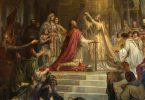It is useful to understand how the transformation from ‘God as One’ to ‘God the Father, God the son, and God the Holy Ghost’ took hold. You will, on occasions, have to defend the situation. Here is a chronology of the development of the concept of the Trinity. (as per “Missing Documents from the Gospel of Barnabus, Adam Peerbhai, Islamic Institution, Durban 1967, Pg. 28”):
Maryam Jameelah’s book: ‘Islam Versus Ahl al-Kitab: Past and Present.’ makes interesting reading. Her former name was Margaret Marcus.
- AD32: About this the gospels recorded- “I ascend uto my Father and your Father and my God and your God!
- AD 57: About this time Saul/Paul wrote, “There is but one God and Father and son, Jesus Christ.”
- AD 96: About this time Clement wrote “Christ was sent by God and the aposles were sent by Christ.”
- AD 120: The Apostles’ Creed begins to be known to the Church. I believe in God, the Father Almighty.”
- AD 150: Justin Martyr, about this time, began with platonic philosophy to corrupt Christian simplicity.
- AD 170: The word ‘Trias’ first occurred in Christian literature.
- AD 200: The word ‘Trinitas’ is used by Tertullian.
- AD 230: Origen writes against prayers being offered to Christ.
- AD 260: Sabellius taught that Father, Son, and Holy Spirit are three names for the same God.
- AD 310: Lactanius wrote that ‘Christ never called himself God’!
- AD 320: Eusebius writes “Christ teaches us to call his Father the true God and to worship him”
- AD 325: The Council of Nicea agrees to call Christ God of God, very God of very God! However, two opposing groups, the Trinitarians and the Unitarians, came into existence.
- AD 350: There is great conflict in the Church about the doctrine of Trinity.
- AD 370: The doxology, “Glory be to the Father, the Son and the Holy Ghost” composed and objected to as a novelty.
- AD 381: The Council of Constantinople gives the finishing touch to the doctrine of ‘three persons in one God’.
- AD 383: The Emperor Theodosius threatened to punish all who would not believe in and worship the Trinity!
Therefore, the doctrine of Trinity, imposed by imperial decree, did not become Christian dogma until nearly four centuries after the death of Jesus! In the post Nicene period, the union of the church and state transformed theological error into legal offense!
Orthodoxy was then established by force. We can argue that the concept of the Trinity was created to confuse the common person to the extent that he or she ends up in blind faith and gives up rational thinking. The ‘required’ belief in the ‘Father, Son, and Holy Ghost’ blocks the rational thinking the human brain. Other beliefs can then be pushed upon the believer. The requirement that one ‘must accept and believe’ destroys the practical rationality of the believer.
As Christians, we must prefer truth and rational thinking over dogma.
Our problem as everyday practical rational thinking Christians is that the formal doctrine of the Trinity is a hallmark of orthodox Christianity, meaning ‘The Church’. The Church also developed a doctrine of ‘salvation by grace through faith’, whereas a practical Christian who learned his moral stand from his parents who got it from their parents would believe that on the day of judgment, they will be judged on their actions — how they treated others. As I commonly state: “If you were brought up in the West, and you believe in common decency, you are Christian.”
The difficulty of a rational person to accept the Holy Trinity is a serious impediment to the acceptance of Christianity in this era of mathematics, science, and logical thinking. In the past, it was a heresy to dispute the Trinity, however, at the time the concept of the Trinity was brought into force, there were many that did ont accept it. We must state that not accepting the Trinity is not a reason to be classed as a non-Christian. The non-Trinity person is simply a Christian that does not accept the dogma of the Church — a dogma that was voted into dogma at a meeting of persons centuries after the death of Jesus. Christ Himself warned His followers: “Take heed that no one deceives you. For many will come in My name . . . and will deceive many” (Matthew 24:4-5).
Barely two decades after Christ’s death, apostle Paul wrote that many believers were “turning away . . . to a different gospel” (Galatians 1:6). He wrote that he had to contend with “false apostles, deceitful workers” who were fraudulently “transforming themselves into apostles of Christ” (2 Corinthians 11:13). He had a major problem dealing with “false brethren” (2 Corinthians 11:26). Somehow, we are expected to be confident that Paul was the ‘genuine article’ and the others were the fakes. For the most part, people were called Christians if they followed the ways of Jesus. Jesus never said you had to go to church to sit and be lectured. With all these different messages being given, the Christianity where people followed ‘the ways of Jesus’ were compromised with practices originating in paganism. We can divide Christianity up into ‘Christianity of the people’ and Christianity of the Church’. Some of the practices of previous religions took hold and modified the faith founded by Jesus Christ into the form we see in ‘The Church’. We should support the Church but be wary of its insistence on Trinity and blind faith. Some might say that ‘The Church’ has drifted far from the teachings of Jesus Christ and is Christian in name alone.
References:
- Man-made Christianity. https://www.beautifulislam.net/christianity/man-made_trinity.htm






